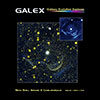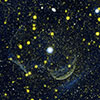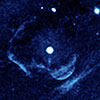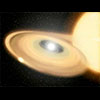Press Release
GALEX Finds Link Between Big and Small Stellar Blasts
Proof that certain double star systems can erupt in full-blown explosions and then continue to flare up with smaller bursts has been spotted by the ultraviolet eyes of NASA's Galaxy Evolution Explorer.
The finding bolsters a 20-year-old theory that suggests such double-star, or binary systems, should eventually undergo both types of explosion, rather than just one or the other. It implies the systems probably cycle between two blast types, hiccupping every few weeks with small surges until the next giant outburst about 10,000 years later.
"The new images are the strongest evidence yet in favor of the cyclic evolution of these binary stars," said Dr. Mike Shara of the American Museum of Natural History, New York, lead author of a new paper that details the finding in the March 8 issue of the journal Nature. "It's gratifying to see such strong evidence for this theory finally emerge after all this time."
The new discovery centers around Z Camelopardalis (Z Cam), a stellar system that astronomers have long known to be a cataclysmic binary -- a system featuring a collapsed, dead star, or white dwarf, which behaves like a vampire sucking hydrogen-rich matter from a companion star. The stolen material forms a rotating disk of gas and dust around the white dwarf.
Astronomers divide cataclysmic binaries into two classes -- dwarf novae, which erupt in smaller, "hiccup-like" blasts, and classical novae, which undergo huge explosions. Classical novae explosions are 10,000 to a million times brighter than those of dwarf novae, and they leave behind large shells of shocked gas.
About 530 light years from Earth, Z Cam was one of the first dwarf novae ever detected. For decades, observers have watched the system hiccup with regular outbursts. It brightens about 40-fold every 3 weeks or so, when an instability causes some of the material drawn by the stellar vampire to crash onto the white dwarf's surface.
Theory holds that Z Cam and other recurring dwarf novae should eventually accumulate enough matter and pressure from their swirling disks of hydrogen to trigger gigantic hydrogen bombs - classical novae explosions. But no one had found definitive evidence that a binary had experienced both types of blasts until the Galaxy Evolution Explorer's observations of Z Cam, which began in 2003.
That's when Dr. Mark Seibert of the Carnegie Institution of Washington in Pasadena, Calif., serendipitously noticed a never-before-seen arc and linear features surrounding Z Cam in imaging data the Galaxy Evolution Explorer collected during its Survey of Nearby Galaxies. The features indicated the presence of a massive shell around Z Cam -- evidence that the dwarf nova had in fact undergone a classical nova explosion a few thousand years ago.
Previous observations had failed to reveal the massive shell because it cannot be easily detected at optical wavelengths. It is, however, easily seen at the ultraviolet wavelengths detected by the Galaxy Evolution Explorer.
"You could actually see it immediately," Seibert said. "But we had to convince ourselves that we were really seeing a nova remnant."
Narrowband images from Kitt Peak National Observatory near Tucson, Ariz., Palomar Observatory near San Diego, Calif., and the Wise Observatory near Mizpe Ramon, Israel, along with optical spectroscopic measurements made at the Lick Observatory near San Jose, Calif., by other team members confirmed that the structures detected in the Galaxy Evolution Explorer imaging data were indeed a massive shell of gas surrounding Z Cam.
The authors of the new paper write that Z Cam's classical nova explosion must have been quite spectacular. "During that eruption," they write, "it must have become, for a few days or weeks, one of the brightest stars in the sky."
The California Institute of Technology in Pasadena, Calif., leads the Galaxy Evolution Explorer mission and is responsible for science operations and data analysis. NASA's Jet Propulsion Laboratory, also in Pasadena, manages the mission and built the science instrument. The mission was developed under NASA's Explorers Program managed by the Goddard Space Flight Center, Greenbelt, Md. Researchers from South Korea and France collaborated on this mission.
Media Contacts:
Jane Platt 818-354-5011
Jet Propulsion Laboratory, Pasadena, Calif.







